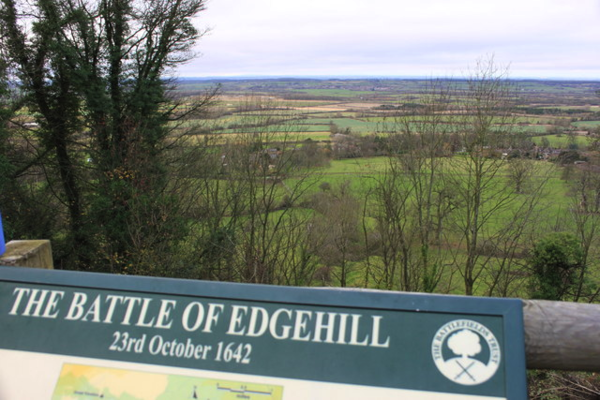The Battle of Edgehill
Royalist and Parliamentarian forces had already fought at Powick Bridge, but the Battle of Edgehill, which took place on 23 October 1642, was the first pitched battle of the English Civil War. The battle commenced at around three o'clock in the afternoon, but military events continued for a further two days, culminating with a Royalist attack on part of the Parliamentarian baggage train in Kineton on the Tuesday.
On 22 October, the armies accidently stumbled upon each other in Warwickshire. Because of the communication difficulties of the time, Essex did not know what route Charles was taking to London.
The battle took place in fields between the villages of Kineton and Radway on 23 October 1642. Edgehill was at the bottom of a hill. The Royalists, led by the king, gathered on the Edge Hill escarpment. The Royalist cavalry was led by Prince Rupert and Lord Wilmot. Essex’s parliamentary forces gathered in the fields below. The Royalists therefore had the advantage of higher ground, allowing them to track Essex’s movements. The Royalist army numbered approximately 13,500 men; the parliamentarians had approximately 12,500 men, with around 3,500 on their way to the battlefield.

Essex chose not to attack the well-positioned Royalists first. Attacking uphill would have been difficult. At around midday, the Royalists started to descend from Edgehill. The parliamentarians responded with artillery fire.
Prince Rupert launched the first attack. It was a cavalry charge against the Parliamentarians, led by Sir Faithful Fortescue. When Fortescue was confronted by Rupert’s advancing men, he rapidly changed allegiances and attacked the Parliamentarians too. Almost the whole left flank of Parliament’s men, commanded by Sir James Ramsay, fell apart, and Prince Rupert’s cavalry pursued Ramsay. On the other flank, Fielding’s regiment fell apart and Wilmot’s cavalry pursued them to Kineton. However, by pursuing the Parliamentarian cavalry beyond the battlefield, the Royalist cavalry lost the decisive advantage they had gained in their initial attack, and when they returned to the battle they did not make such a great impact.
Foot soldier dominated the heart of the battle and the Parliamentarians were more successful: they managed to halt and push back the King’s footsoldiers. Royalist foot soldiers at the centre had no obvious commander and fell into disarray. As night fell, the battle petered out.
There was no clear victor at the end of the battle. Both the Parliamentarians and Royalists lost around 1,500 men. Roundhead and Cavalier infantrymen bore the brunt of the casualties. Both sides claimed a victory. When it became clear that his men were exhausted, Essex gave up on his plans to continue the battle the following day. The night had been freezing. The Royalists were also unwilling to recommence the battle. Essex withdrew his men to Warwick. The Royalists then continued their march southwards towards London.
See also: The First Battle of Newbury
MLA Citation/Reference
"The Battle of Edgehill". HistoryLearning.com. 2025. Web.
